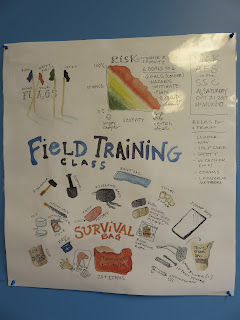Got safety?
“It
looks like an old mining town, but it feels like a college campus.”
 |
| A group of artists at McMurdo drew this summary of the field training class a few years ago. |
Ben
smiled at his own cleverness as everyone in the room chuckled. The bearded,
cheery-faced instructor had asked us to introduce ourselves by stating our
name, home institution, and a weird observation about McMurdo Station. His
observation was spot on.
We
were seated in a classroom on the upper floor of the Science Support Center. On
the white board in front of us, another instructor had scrawled the caption “Risk
Management” and drawn a graph to accompany it. The space between the axes,
labeled “Consequences” and “Probability,” was shaded with diagonal areas of
green, yellow, orange, and red.
As
you may imagine, working in Antarctica requires a lot of safety training. Three
whole days of it – and that’s just for standard tasks. The training here is
much more comprehensive than anything I’ve received in the Arctic (I only had mandatory training on one trip, and it lasted less than a day), but then again,
the risks here are also more comprehensive. We have learned how to determine if
a heavyweight vehicle can safely cross over a crack in sea ice. We have
practiced lighting outdoor stoves to melt snow for drinking water. We have been
shown how to treat hypothermia, frostbite, and snowblindness. We have been
taught how to identify distant oncoming storms and navigate home in low
visibility.
 |
| Flags mark routes and hazards on the ice. This flag line denotes a foot path out to a hole in the ice for sampling. |
One
major difference between Arctic and Antarctic trips for me is the methods for accessing marine environments. In the Arctic, I’ve always been on a ship. Easy.
Down here, though, the sea ice is much more extensive, and it sticks around for
more of the year. Rather than driving a ship through meters-thick ice in
McMurdo Sound just to lower a sampler over the side, it’s easier and less
destructive to go out on the ice ourselves. The vast majority of our
risk-management training so far has actually pertained to working on the sea
ice, and there are plenty of scientists doing it. There flagged routes on the
ice showing where it’s safe to drive snowmobiles. There are established drill
holes where everything from plankton nets to SCUBA divers can enter the water.
There is an official protocol for landing a helicopter near the ice edge.
I
have one more day of training tomorrow, and it involves practical application
of skills in the field. It will be my first time out on the ice, and I cannot
wait. Antarctica has given me a plethora of new experiences so far, but I am anxious
to get out of the station and explore even more. Bring it on, Antarctica!
Comments
Post a Comment